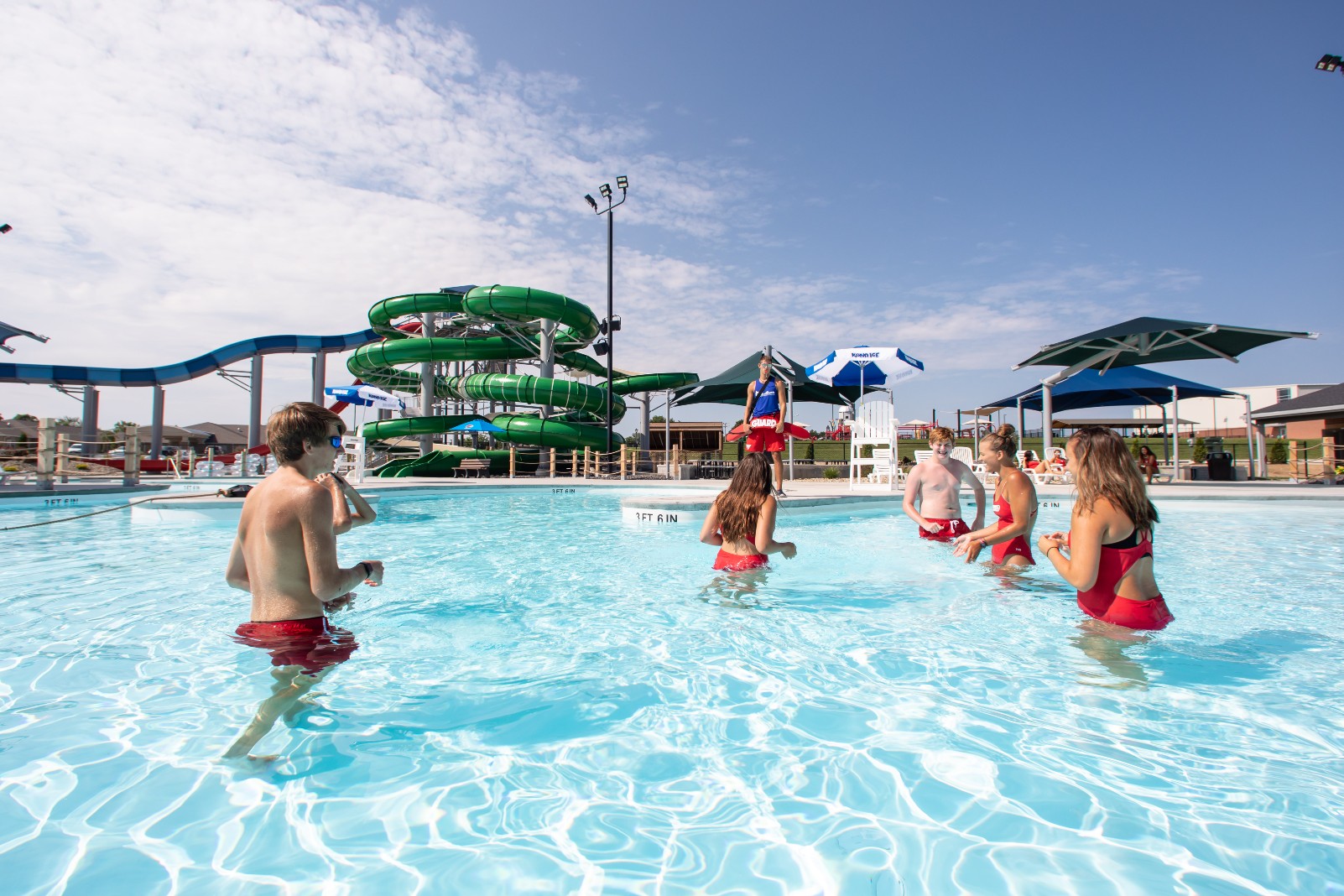Can you believe we’re entering our second pandemic summer? Here we are more than a year after “two weeks to flatten the curve,” and we’re still grappling with the ramifications of COVID-19. Fortunately, many states are rolling back restrictions as vaccinations rise and many people will be desperate to get back into the pool.
All of this means swim season 2021 will bring a variety of new and different challenges.
This year’s edition of the Aquatics Facility Handbook offers a primer for getting your aquatics center equipped for an unusual season ahead, whether it’s your first time opening since the shutdown or your second time operating under these circumstances. Here’s how to make the most of a difficult situation.
Prepare Your Facility
As though reopening your facility weren’t challenging enough under normal circumstances, this swim season requires even more diligence.
In addition to the typical protocol, you’ll need to prepare the facility following stringent local health guidelines designed to protect guests and staff from COVID-19. Of course, regulations vary across jurisdictions, so operators suggest contacting your local health officials now so there are no surprises later.
“I think we’re all going to be slammed this summer, kind of figuring things out. So I think my best tips for working with your local health official is to make contact with them early,” advises Miklos Valdez, studio director at the Counsilman-Hunsaker Aquatic Management Program. “Develop a good rapport with them and let them know that you’re willing to work with them on any updates or changes that they would like to see at the facility.”
That could include things such as signage to encourage social distancing and wearing masks — outside the pool, of course. Officials may want you to undertake larger projects as well. For instance, your local health authority might require retrofitting your HVAC system to increase ventilation.
Pools that have been dormant for more than a year due to the shutdown need to take extra precautions. Lifesaving equipment and mechanical systems can fall into disuse. Inspect the following thoroughly:
• Life vests, head immobilizers, backboards, rescue tubes: Plastic parts can become brittle. Make sure that straps and clips still function.
• Filters, pumps and chemical feeders: Have a pool maintenance professional test each pool component to ensure that they’re still in good working order. Does the filter media need to be replaced? Sand can calcify over time.
• Chemicals and testing equipment: Dry chemical products can last for years if stored in a cool, dry space. However, other maintenance products have a more limited shelf-life. Liquid chlorine, for example, gradually loses its effectiveness. Also, test reagents expire after a couple of years. Replace as necessary.
• Plumbing lines: Stagnant water in your plumbing lines can breed dangerous bacteria such as Legionella. Be sure that your facility’s water system is safe for washing and showering.
Update Your Guests
For many visitors, it will be their first time stepping foot in a public swimming pool in well over a year. Your aquatics center likely won’t be the same as they remember it. So it’s good to help them prepare.
From reduced hours to stricter capacity limits, changes to your facility need to be communicated clearly and by using a multitude of channels. You don’t want guests turning away disappointed that your pool isn’t, for instance, offering open swim this season. Others may not expect the need to reserve time in advance.
Maggie McDonald, consultant at risk-management firm The Redwoods Group, suggests using if-then statements on your website, social media and in e-mails to give members an idea of what to expect based on local regulations. For example: “If our facility is required to operate at 25% capacity, then you will have to use our reservation system to schedule your pool time.”
Facilities have also taken to YouTube to post videos answering frequently asked questions or explaining how to reserve a lane for lap swim.
Just as important as it is to outline expectations before guests arrive, your staff must be prepared to clearly communicate with them at the pool. Some staffers may find themselves in the uncomfortable position of having to remind a guest to respect social distancing protocol and wear a mask outside of the pool — or maybe even telling a guest to remove their mask in the pool.
“How do we handle all these types of conversations?” McDonald asks.
The answer: Training, and lots of it. Cover every conceivable scenario and figure out as many solutions as needed. In the case of the in-the-pool-mask-wearer, for instance, staff can offer a face shield.
You also need to inform guests that they’re assuming greater risk of contracting COVID-19 and that the aquatics center is in no way liable. The Redwoods Group has required much stronger waivers over the past year, including language around COVID-19 and other communicable diseases. If you haven’t already, consult your attorney and insurer to see if you should revise your facility’s liability waiver to better protect your organization from a lawsuit.
Invest in a Reservation System
People have been cooped up in their homes for more than a year and they’re eager to get back in the water. Unfortunately, many facilities continue to operate with restricted capacities.
That’s why some are turning to reservation systems to help manage the tsunami of demand. A number of software programs allow members to easily book lanes for scheduled blocks of time, helping aquatics centers ensure safe physical distancing.
Through these programs, you also can outline expectations and require guests to mark a box confirming that they understand the instructions before attending the pool. Other features include notifications, contactless check-ins, the ability for members to scan a QR code upon arrival, along with online payments. This also takes some of the burden off the front-desk personnel and managers struggling to fill positions.
If budget doesn’t accommodate an advanced software package, you could create a Google spreadsheet that allows guests to see which times are available. Then they can call to reserve a time.
Recruit Creatively
Lifeguards have long been in short supply, and COVID isn’t helping matters.
Operating at 25% capacity may help in that regard. Fewer guests means fewer guards. But what happens later in the summer when pools are permitted to host more people? Who will step up to sit in the lifeguard chair? Operators will have to cross that bridge when they get there. For now, many are having to make due with a small staff.
“A lot of them have made the comment that not opening is not an option, so they’re going to figure out how to make it work,” Valdez says.
In short, they’re having to do more with less. One strategy is identifying those guests who can’t swim and requiring that they wear U.S. Coast Guard-approved life jackets, so that lifeguards can channel their efforts toward keeping swimmers safe. It’s what Rachel Griffiths, Ph.D., refers to as the “Note and Float” program, which is also the name of her foundation that donates life jackets to aquatics centers.
“This not only directly prevents drowning, but helps lifeguards be more effective,” says Griffiths, communications director at the Aquatic Safety Research Group.
Here are several more ways aquatics centers can better utilize their limited staff while reeling in more candidates.
• Reserve non-lifeguards to help with sanitizing, monitoring physical distancing and other tasks that do not require water vigilance. You may even find volunteers for these roles.
• Do as much as you can remotely. Interviewing candidates via video conference can streamline the application process. Likewise, conducting training sessions and team meetings via Zoom is more convenient and further protects lifeguards from exposure.
• See if there is a neighboring pool facility you can partner with to share lifeguards and other resources.
• Aim higher, as in age. Some facilities have found success recruiting retirees as lifeguards.
Gear Up
You’ll need to add a few more things to your long list of equipment needs this season.
Beyond the usual lifesaving devices and pool maintenance supplies, you’ll need to stock up on necessities to protect guests and staff from the coronavirus.
“Everyone is expecting a higher level of cleaning and sanitation, so consider what you’re going to do for that, how you’re going to address that between groups coming in,” offers Peter Beireis, senior recreation services supervisor at the City of Newark, Calif.
Your list of COVID personal protective equipment (PPE) will include the obvious: masks and face shields. Also expect sanitation wipes and gallons of sanitizer to take up plenty of storage space. But there are less obvious things, too, that deserve careful consideration.
• Buckets: Many facilities are supplying guests with buckets to store their belongings poolside. This limits people from congregating around cubbies (and keeps the pool deck tidy.)
• More CPR mannequins: Make sure you have a mannequin for each pair of lifeguards to minimize cross contamination.
• More lung bags: Likewise, double-up, triple-up, even, on lung bags for the mannequins so that you can replace them after each use.
“The number one thing I see is that facilities do not change out their mannequins lungs as often as they should,” Valdez says. “They really should be doing it from person to person.”
Embrace Change
The plus side of operating an aquatics center during the second pandemic summer is that you’ve been through this before. You have your protocol in place and emergency preparedness plans locked down. If, however, this is your first go-around, you can network with other operators who’ve been through it all before.
Thankfully, most guests are gracious. They’ve become accustomed to reduced seating at movie theaters and restaurants. They’ll understand if their local pool has limited capacity, too.
And with fewer pool patrons, this may be the perfect time to experiment. Introduce a new aquatics program or use spaces in creative ways. For example, some facilities have found success renting sections of the pool to private parties. Not only does it generate more revenue, “that has helped them kind of manage how many people they have in the facility at one time,” Valdez says.



